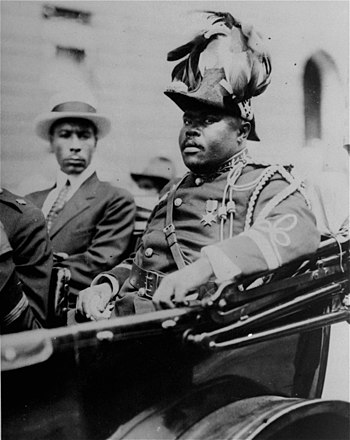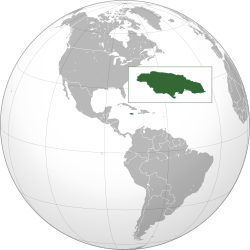Portal:Jamaica
The Jamaica Portal
Jamaica (/dʒəˈmeɪkə/ jə-MAY-kə; Jamaican Patois: Jumieka [dʒʌˈmie̯ka]) is an island country in the Caribbean Sea and the West Indies. At 10,990 square kilometres (4,240 sq mi), it is the third largest island—after Cuba and Hispaniola—of the Greater Antilles and the Caribbean. Jamaica lies about 145 km (90 mi) south of Cuba, 191 km (119 mi) west of Hispaniola (the island containing Haiti and the Dominican Republic), and 215 km (134 mi) south-east of the Cayman Islands (a British Overseas Territory). With 2.8 million people,0 Jamaica is the third most populous Anglophone country in the Americas (after the United States and Canada), and the fourth most populous country in the Caribbean. Kingston is the country's capital and largest city. Most Jamaicans are of Sub-Saharan African ancestry, with significant European, East Asian (primarily Chinese), Indian, Lebanese, and mixed-race minorities. Because of a high rate of emigration for work since the 1960s, there is a large Jamaican diaspora, particularly in Canada, the United Kingdom, and the United States. The country has a global influence that belies its small size; it was the birthplace of the Rastafari religion, reggae music (and such associated genres as dub, ska and dancehall), and it is internationally prominent in sports, including cricket, sprinting, and athletics. Jamaica has sometimes been considered the world's least populous cultural superpower. (Full article...) Selected article - Runaway Bay is a town in Saint Ann Parish on the northern coast of Jamaica and is considered one of the most naturally beautiful places on the island. It is a notable tourist destination located 16 km (9.9 mi) west of Ocho Rios, and slightly east of Discovery Bay, where Christopher Columbus landed in 1494. Ocean View Beach is a private beach situated at Runaway Bay. It consists of a series of hotel resort complexes and beaches. The name derives from its having been an escape route for runaway slaves. Arawaks were the first native settlers, but they were eventually overpowered by Spanish colonisers. (Full article...)Did you know (auto-generated)
Selected biography - Portia Lucretia Simpson-Miller ON (born 12 December 1945) is a Jamaican former politician. She served as Prime Minister of Jamaica from March 2006 to September 2007 and again from 5 January 2012 to 3 March 2016. She was the leader of the People's National Party from 2005 to 2017 and the Leader of the Opposition twice, from 2007 to 2012 and from 2016 to 2017. While serving as prime minister, Simpson-Miller retained the positions of Minister of Defence, Development, Information and Sports. She has also served as Minister of Labour, Social Security and Sport, Minister of Tourism and Sports and Minister of Local Government throughout her political career. Following her election win in December 2011, when her party defeated the Jamaica Labour Party, she became the second individual since independence to have served non-consecutive terms as prime minister, the first having been Michael Manley. The People's National Party under her leadership lost the 25 February 2016 general election by only one seat to the Andrew Holness-led Jamaica Labour Party. One political commentator described the poll as "the closest election Jamaica has ever had". Following this defeat, Simpson-Miller stepped down in 2017. (Full article...)General images -The following are images from various Jamaica-related articles on Wikipedia.
This is a Good article, an article that meets a core set of high editorial standards.
The 1944 Jamaica hurricane was a deadly major hurricane that swept across the Caribbean Sea and Gulf of Mexico in August 1944. Conservative estimates placed the storm's death toll at 116. The storm was already well-developed when it was first noted passing westward over the Windward Islands into the Caribbean Sea on August 16. A ship near Grenada with 74 occupants was lost, constituting a majority of the deaths associated with the storm. The following day, the storm intensified into a hurricane, reaching its peak strength on August 20 with maximum sustained winds of 120 mph (195 km/h). At this intensity, the major hurricane made landfall on Jamaica later that day, traversing the length of the island. The damage wrought was extensive, with the strong winds destroying 90 percent of banana trees and 41 percent of coconut trees in Jamaica; the overall damage toll was estimated at "several millions of dollars". The northern coast of Jamaica saw the most severe damage, with widespread structural damage and numerous homes destroyed across several parishes. In Port Maria, the storm was considered the worst since 1903. Land interaction weakened the hurricane, and the storm maintained this lessened intensity as it passed the Cayman Islands, producing measured gusts of 80–90 mph (130–140 km/h). On August 22, the hurricane moved ashore the Yucatán Peninsula near Cozumel and eventually emerged into the Bay of Campeche as a tropical storm. On August 24, the storm made landfall for a final time near Tampico, Mexico, bringing with it heavy rains that caused flooding throughout the coasts of Veracruz and Texas, killing 12. The storm dissipated over the mountainous terrain of inland Mexico later that day. Heavy rains were reported across the Rio Grande Valley, causing minor flooding. A tornado produced by the storms killed one person in McCook, Texas and injured fifteen others. (Full article...)Selected picture - Marcus Garvey was a Jamaican political activist, publisher, journalist, entrepreneur, and orator. The government of Jamaica named him as the country's first National Hero. Pictured is Marcus Garvey in Harlem, New York City in 1922.
Selected cuisines, dishes and foods -Rice and peas or peas and rice are traditional rice dishes within some Caribbean countries. The 'peas' used in this dish by some countries are traditionally pigeon peas otherwise called 'Gungo peas' in the Caribbean. Either kidney beans (red peas) or pigeon peas are generally used for this dish. Rice and peas recipes throughout the Caribbean vary, with each country having their own way of making it and name of calling it, and are similar only by the two main ingredients which are the legumes (peas/beans) used and rice to form a mixture. The name "rice and peas" originally is used by Jamaicans to identify the dish, while other countries have different names for it. In 1961, Frederic G. Cassidy made note that the dish had been referred to as Jamaica's coat of arms. (Full article...)
More did you know
Selected listsTopicsCategoriesRelated portals
WikiProjectsGeographical:
History and Society:
Tasks
Associated WikimediaThe following Wikimedia Foundation sister projects provide more on this subject:
More portals | ||||||||||





















































